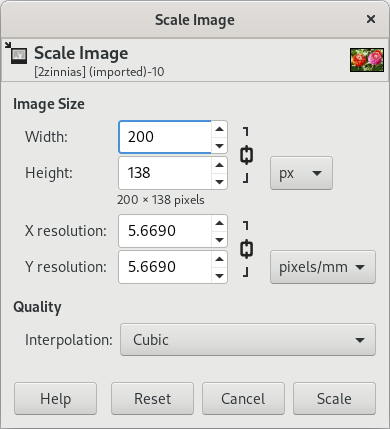Kommandoen forstørrer eller formindsker billedets fysiske størrelse ved at ændre antallet af pixels, det indeholder. Den ændrer størrelsen på billedets indhold og ændrer størrelsen på lærredet i overensstemmelse hermed.
Det virker på hele billedet. Hvis dit billede har lag i forskellige størrelser, kan det at gøre billedet mindre få nogle af dem til at skrumpe til ingenting, da et lag ikke kan være mindre end en pixel bredt eller højt. Hvis det sker, vil du blive advaret, før handlingen udføres.
Hvis du kun vil skalere et bestemt lag, skal du bruge kommandoen Skalér lag.
![[Bemærk]](images/note.png)
|
Bemærk |
|---|---|
|
Hvis skalering ville give et billede, der er større end den “maksimale nye billedstørrelse”, der er angivet på siden Systemressourcer i dialogen Indstillinger (som har en standardværdi på 128 MiB), bliver du advaret og bedt om at bekræfte handlingen, før den udføres. Du oplever muligvis ingen problemer, hvis du bekræfter handlingen, men du skal være opmærksom på, at meget store billeder bruger mange ressourcer, og ekstremt store billeder kan tage flere ressourcer, end du har, hvilket får GIMP til at gå ned eller ikke fungere godt. |
- Billedstørrelse
-
Du skal huske på, at et billede kan befinde sig fire steder: i billedfilen, i RAM efter indllæsning, når det vises på skærmen, og på papir efter udskrift. Skalering af billedet ændrer antallet af pixels (mængden af information), som billedet indeholder, så det påvirker direkte den mængde hukommelse, som billedet har brug for (i RAM eller i en fil).
Men udskriftsstørrelsen afhænger også af billedets opløsning, som i bund og grund bestemmer, hvor mange pixels der vil være på hver tomme papir. Hvis du vil ændre udskriftsstørrelsen uden at skalere billedet og ændre antallet af pixels i det, bør du bruge dialogen Udskriftsstørrelse. Skærmstørrelsen afhænger ikke kun af antallet af pixels, men også af skærmopløsningen, zoomfaktoren og indstillingen af Punkt for punkt.
Hvis du forstørrer et billede ud over dets oprindelige størrelse, beregner GIMP de manglende pixels ved hjælp af interpolation, men tilføjer ingen nye detaljer. Jo mere du forstørrer et billede, jo mere sløret bliver det. Udseendet af et forstørret billede afhænger af den interpolationsmetode, du vælger. Du kan forbedre udseendet ved at bruge filteret
Det kan være nødvendigt at reducere dit billede, hvis du har tænkt dig at bruge det på en webside. Du skal tænke på, at de fleste internetbrugere har relativt små skærme (f.eks. på mobile enheder), som ikke kan vise et stort billede helt.
At tilføje eller fjerne pixels kaldes “Gensampling”.
- Bredde, Højde
-
Når du klikker på kommandoen , viser dialogen det oprindelige billedes mål i pixels. Du kan indstille den Bredde og den Højde, du vil give dit billede, ved at tilføje eller fjerne pixels. Hvis kædeikonet
ved siden af boksene Bredde og Højde er ubrudt, vil Bredde og Højde forblive i samme forhold til hinanden. Hvis du bryder kæden ved at klikke på den, kan du indstille dem uafhængigt af hinanden, men det vil forvrænge billedet.
Du behøver dog ikke at angive dimensionerne i pixels. Du kan vælge forskellige enheder i rullemenuen. Hvis du vælger procent som enhed, kan du indstille billedstørrelsen i forhold til den oprindelige størrelse. Du kan også bruge fysiske enheder, som f.eks. inch eller millimeter. Hvis du gør det, skal du indstille felterne x-opløsning og y-opløsning til passende værdier, fordi de bruges til at konvertere mellem fysiske enheder og billeddimensioner i pixels.
- x-opløsning, y-opløsning
-
Du kan indstille udskriftsopløsningen for billedet i felterne x-opløsning og y-opløsning. Du kan også ændre måleenhederne ved at bruge rullemenuen.
- Kvalitet
-
For at ændre billedstørrelsen skal der enten fjernes nogle pixels eller tilføjes nye pixels. Den proces, du bruger, bestemmer kvaliteten af resultatet. Rullelisten Interpolering giver et udvalg af tilgængelige metoder til at interpolere farven på pixels i et skaleret billede:
Interpoleringsmetoder er beskrevet i Interpolering.
![[Bemærk]](images/note.png)
|
Bemærk |
|---|---|
|
Se også værktøjet Skalering, som lader dig skalere et lag, en markering eller en kurve. |




